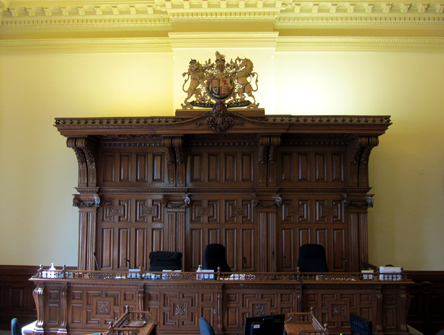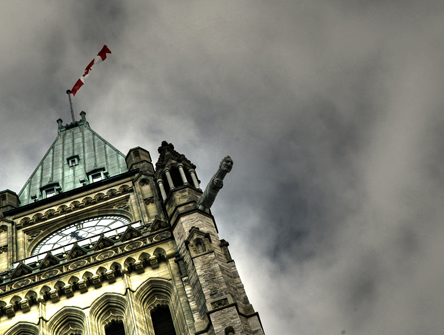Judicial opposition
From Senate reform to the Nadon decision, recent Supreme Court rulings have resurrected cries of judicial activism. But some experts find the critics are out of order.

It was a busy start to spring for Beverley McLachlin. On March 21st, the Supreme Court of Canada ruled that Marc Nadon was ineligible to fill a Quebec seat on the Supreme Court, as his appointment was contrary to provisions of the Supreme Court Act. Then, in late April, barely a month after her 25th anniversary as a Supreme Court judge, the Prime Minister’s Office issued a statement suggesting that the Chief Justice had inappropriately tried to reach Stephen Harper by telephone to warn him ahead of time of the eligibility problem.
No doubt the PMO’s dust-up with the Chief Justice will still be on people’s minds when McLachlin, who was appointed by Brian Mulroney in 1989, celebrates a new milestone in January: Becoming the first person to have served 15 years as Chief Justice.
It was in 2000 that Jean Chrétien asked her to head Canada’s judicial branch. At the time, a narrative had taken root among the Court’s critics: After two decades largely focused on interpreting the Charter of Rights & Freedoms, the Supreme Court under Justices Laskin, Dickson and Lamer had become too activist.
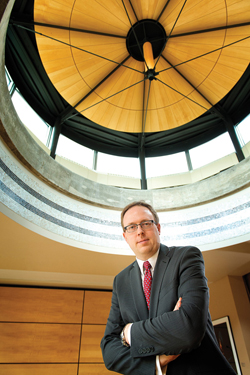
Photo of Dwight Newman, University of
Saskachewan
by Kasdorf Photographics
A 2010 National published a cover story assessing the “McLachlin Court” after 10 years and its influence on Canadian law. The article painted the portrait of the Chief Justice managing to “steer the top Court away from a lot of controversy.” Dwight Newman, a professor of aboriginal and constitutional law at the University of Saskatchewan agrees, saying, “After 2000, we saw these preoccupations diminish, compared to what it was in the 1990s.”
Fairly or not, it seems that the Court has once again become the target of political controversy. There’s the Nadon reference, of course. But the government has suffered a string of defeats of late, from Senate reform to the creation of a national securities regulator, as well as the ruling on supervised injection sites in Vancouver and judicial sentencing discretion with respect to credit for time served.
In each of these rulings, the Supreme Court refused to give the green light to some of the Harper government’s most controversial decisions.
And once again, the term “judicial activism” — which had all but disappeared from the national vocabulary for years — is making a comeback.
“I’m not ordinarily one to cry ‘judicial activism,’ but this surely fits the description,” wrote columnist Andrew Coyne in the National Post after Justice Nadon’s appointment.
“In fulfilling their obligation to uphold the Charter of Rights, the Courts have emerged as the real opposition to Harper’s crime agenda,” added Steve Sullivan, former Federal Ombudsman for Victims of Crime.
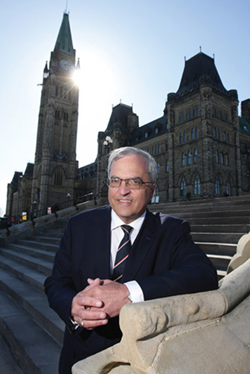
But is there any real truth to statement? Has the McLachlin Court suddenly become the embodiment of some form of new judicial “opposition”?
Hardly, say many legal experts and observers. Henry Brown, of Gowlings’ Ottawa office, has spent 33 years representing and advising the Supreme Court of Canada. He has worked alongside four chief justices. He even attended Beverley McLachlin’s swearing-in ceremony in the late 1980s.
“Some of her judgments no doubt annoy the government,” Brown said in a recent phone interview a few weeks before taking retirement.
“But that is the function of applying the Charter,” he added. “And she has been as steadfast in her respect for the Charter under Mr. Harper, for example, as she was under Mr. Martin, Mr. Chrétien and under Mr. Mulroney.”
“In some ways the pattern of losses before the Supreme Court has more to do with the Harper government’s approach to constitutional issues than it does his relationship with the Court itself,” says Emmett Macfarlane, an assistant professor of political science at the University of Waterloo and an avid Supreme Court commentator — notably on Twitter.
A few minutes after the Senate reform ruling was released, Liberal MP Stéphane Dion made a similar comment, noting that the ruling “says much more about the government” than about the Supreme Court: “Mr. Harper has to learn that Canada is a federation and a constitutional state, and that there are things you can’t do.”
Some experts believe that the Court’s philosophy concerning the need for cooperation between the various levels of government is not extraneous to the recent case law developments.
“But,” Macfarlane adds, “the Court has increasingly taken an approach, and I think it does reflect the Chief Justice’s philosophy, that there are so many overlapping areas of jurisdictions in Canadian federalism, that the Court has really tried to encourage this idea of collaborative federalism — this notion that where these ideas do overlap, there is a need for federal-provincial engagement and cooperation.”
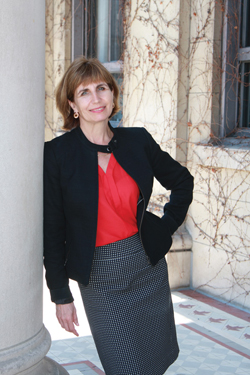
The Senate reference was an opportunity to renew that commitment to federal-provincial cooperation, in addition to underlining the “fundamental” role the unpopular Upper House plays in the Canadian constitutional system.
In the same vein, the reference on Justice Nadon’s appointment saw the Court acknowledge “Quebec’s distinct social values,” in finding the appointment to be unconstitutional in addition to constitutionalizing its own existence. “This is no small matter!” comments Nathalie Des Rosiers, Dean of the Faculty of Law at the University of Ottawa who views the ruling as one of the most important developments of the last five years, and as indicative of a broader philosophy prevailing on the McLachlin Court.
“There is no philosophy of judicial activism,” opines Des Rosiers, a specialist in constitutional law, human rights and women’s rights. “It’s rather an affirmation of the importance of the judicial branch.”
Too cautious?
To maintain the delicate balance between the government’s rights and the division of powers, Des Rosiers says that the McLachlin Court leaves the government a great deal of latitude under Section 1, particularly on national security issues.
“This is a Court that insists on accountability, but which also leaves the government a lot of leeway on issues that the government sees as priorities,” she says.
That is precisely what bothers Rocco Galati, a Toronto lawyer who specializes in terrorism cases. Galati was the first person to question the appointment of a Federal Court of Appeal judge to fill one of the three seats reserved for Quebec judges on the Supreme Court. He views this decision, as well as the decision on Senate reform, as “anomalies.” Furthermore, he finds that accusing the Supreme Court of judicial activism is totally farfetched. He considers the situation to be quite the opposite: “As somebody who does nothing but litigate against the government, I don’t have that assessment.”
In fact, Galati finds that the Supreme Court is too cautious and refuses to hear too many cases that would put it at loggerheads with the government, particularly in matters relating to terrorism. He adds that a willingness to “dialogue” with Parliament, rather than handing down firm rulings on its laws and policies, would be a misrepresentation of its role.
“I think there is a blurry line between the independence of this Court and the government. A Supreme Court, in my view and the view of a lot of lawyers I talk to, is not supposed to be dialoguing with Parliament. They rule on Parliament’s laws.”
Other developments
In spite of the recent controversies, most of the observations made on the 10th anniversary of the Chief Justice’s term still hold. Her most cited achievement is to have succeeded in fostering greater unanimity on a Court that has built a reputation for producing clearer decisions.
Catherine Beagan Flood clerked for former Chief Justice Antonio Lamer. She also applauds the Court’s efforts at making itself more accessible. “Unlike 10 years ago, now anyone can go to the Court’s website and read all the written arguments and even watch a webcast of the oral hearing. I think that has meant that the Court has taken great strides in transparency and accessibility to ordinary Canadians and that increases confidence and understanding of the Court’s role and in the Court’s decisions,” says Beagan Flood, who is now with Blakes in Toronto, and who has pleaded before the Supreme Court a number of times.
In the last five years, there have been other important judicial developments — notably in terms of freedom of religion. Des Rosiers notes that the trend observed toward the end of the last decade in Alberta v. Hutterian Brethren of Wilson Colony has solidified. She sees “a liberal attitude to freedom of religion, but which recognizes ever firmer limits on freedom of religion in its daily practice.”
The ruling in Vancouver (City) v. Ward, regarding the award of damages for the violation of rights guaranteed by the Charter, is also an important step forward, Des Rosiers says.
Other major rulings since 2000 include Haïda Nation, concerning the acknowledgment of a state obligation to consult the First Nations; Chaoulli, on the privatization of health care; Grant v. Torstar, on freedom of expression and the freedom of the press; the Pro-Sys, Sun Rype and Infineon trilogy, on indirect purchaser class actions; and Grant and Harrison on the admissibility of evidence and unlawful detention.
Other debates on the horizon
In an interview with the National four years ago, Chief Justice McLachlin indicated that the Court was revisiting issues pertaining to the division of powers once again, after years of relative calm on that front.
Clearly these issues, as well as the role and limits of Canada’s institutions, are back on the front burner.
In a recent speech, the Chief Justice predicted that, going forward, the key issue will be reconciliation with the First Nations.
Other politically sensitive cases, namely those concerning the legalization of euthanasia, minimum sentences for possession of firearms, and the destruction of the firearms registry, will also be heard. There is also the anticipated appointment of two judges from Quebec. And it remains to be seen what the long-term fallout will be from the public disagreement in May between the PMO and the Chief Justice.
Federal “opposition” or not, the least that can be said is that the Supreme Court is once again in the spotlight, four years before the end of Beverley McLachlin’s term in 2018. There is time yet for her to continue leaving her mark.

